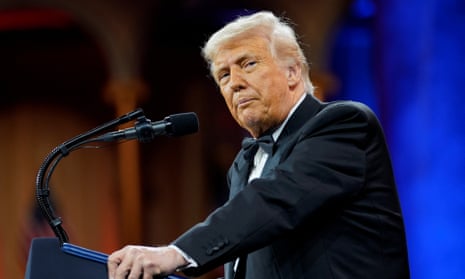Summary
In case you’re just catching up with the latest upheaval in Donald Trump’s deepening global trade war, here’s a recap of today’s developments. And you can read our latest full report here.
-
Trump’s new wave of tariffs on dozens of economies came in force on Wednesday, including 104% levies against Chinese goods, as Washington and Beijing were locked in a high-stakes game of brinkmanship.
-
Rates on imports to the US from exporters like the European Union or Japan rose further at 12.01am (05.01am BST) Wednesday, after the imposition of sweeping 10% tariffs rocked the global economy since coming into force over the weekend.
-
China has been hardest hit by the tariffs but has shown no signs of backing down, vowing to fight a trade war “to the end” and promising countermeasures to defend its interests. China’s retaliatory tariffs of 34% on US goods are due to enter in force on Thursday.
-
Trump said on Tuesday his government was working on “tailored deals” with trading partners, with the White House saying it would prioritise allies like Japan and South Korea. His top trade official Jamieson Greer also told the Senate that Argentina, Vietnam and Israel were among those who had offered to reduce their tariffs.
-
Trump told a dinner with fellow Republicans on Tuesday night that countries were “dying” to make a deal. The US president said: “I’m telling you, these countries are calling us up kissing my ass.”

-
A sell-off across Asian markets resumed on Wednesday, with Japan’s Nikkei down more than 3%, Hong Kong plunging more than 3%, South Korea’s currency hitting a 16-year low and government bonds suffering heavy losses. Australian shares lost billions of dollars of value, while Taiwain stocks fell 5.8% in afternoon trading. Trillions in equity have been wiped off global bourses in the past days.
-
Foreign exchange markets also witnessed ructions, with the South Korean won falling to its lowest level against the dollar since 2009 this week. China’s offshore yuan also fell to an all-time low against the US dollar, as Beijing’s central bank moved to weaken the yuan on Wednesday for what Bloomberg said was the fifth day in a row. Oil prices slumped, with the West Texas Intermediate closing below $60 for the first time since April 2021.
-
India’s central bank cut interest rates, citing “challenging” global conditions.
-
The European Union has sought to cool tensions, with bloc chief Ursula von der Leyen warning against worsening the trade conflict in a call with Chinese premier Li Qiang. She stressed stability for the world’s economy, alongside “the need to avoid further escalation”, an EU readout said.
With news agencies
Key events
China’s foreign ministry called on the US to stop its ‘arrogant and bullying behaviour’ after President Donald Trump’s 104% duties on Chinese imports took effect.
Speaking to reporters at a regular media briefing, Chinese foreign ministry spokesperson Lin Jian said the US continued to impose tariffs on China “indiscriminately”.
If the US really wants to solve the problem through dialogue and negotiation, it should adopt an attitude of equality, respect and mutual benefit.
Trump’s “reciprocal” tariffs on dozens of countries began on Wednesday, including 104% duties on Chinese goods. That deepened his global trade war and triggered more widespread selling across financial markets.
US stock market futures were actually positive this morning, but they have now turned negative amid the broader market turmoil. That suggests that share prices on Wall Street could fall further when they open at 9:30am EDT (2:30pm BST).
The S&P 500 is on course for a 0.5% decline, the Nasdaq is set for a 0.2% drop, and the Dow Jones industrial average is set to drop 0.7%.
Chinese leaders to consider economic support in response to tariffs – report
How come Chinese stock market indices rose on Wednesday, when share prices everywhere else slumped? Possible government intervention is one key aspect.
Reuters reported that top leaders from the Chinese government will meet as soon as today to discuss the response to US tariffs and “to discuss measures to boost the economy and stabilise the capital markets”.
The news agency reported:
Senior officials from the State Council, several government and regulatory bodies were expected to attend the meeting, said the two sources.
Some of the measures to stimulate the world’s second-largest economy could be implemented in the coming weeks, the second source said.
The UK’s 30-year bond yield has soared to its highest level since 1998, following a steep sell-off in US government debt.
As mentioned earlier, the US Treasury market is perhaps the most crucial part of the global financial system. Anything that happens there ripples across the world, and so the US bond sell-off has been mirrored in the UK.
The yield on 30-year UK government debt rose to 5.507%, surpassing the 5.472% peak hit in January. Yields move inversely to prices, so a rising yield indicates that prices have dropped.
Higher yields on gilts – UK government bonds – will make things even more difficult for the government in Westminster, as it will raise the cost of borrowing to fund investment.
Chancellor Rachel Reeves is already struggling to find money, and further rises in borrowing costs would limit her room for manoeuvre.
EU to vote on retaliatory 25% tariffs on US exports

Jennifer Rankin
The EU will vote later on Wednesday on imposing retaliatory duties on €21bn of US goods, including agricultural produce, make-up, steel parts and plastics, in Europe’s first act of retaliation against Donald Trump’s tariffs.
The EU is looking at 25% tariffs on scores of goods from almonds to yachts, according to a document seen by the Guardian and first reported by Reuters. Most of the tariffs would apply from 15 May, unless blocked by a large majority of member states.
The measures are a response to the US tariffs on steel and aluminium announced by Trump in February. The EU has chosen goods that can be easily sourced from elsewhere, while some targets are intended to inflict political pain on key Republican states. The European Commission, for example, wants tariffs on US soybeans, grown abundantly in Louisiana, the home state of House of Representatives Speaker Mike Johnson.
A European Commission spokesperson said on Tuesday that the second phase of the EU’s response – retaliatory measures in response to tariffs on cars and the sweeping “reciprocal tariffs” announced on 2 April – would be presented “early next week”.
Around 70% of EU exports to the United States, goods worth €382bn, will be affected by Trump’s tariffs, a move that has rang alarm bells across the continent, amid forecasts of job losses and a hit to economic growth.
EU trade commissioner Maroš Šefčovič said on Monday the EU was “not in the business of going cent for cent or tit for tat or dollar for dollar” when it comes to retaliation on goods. EU officials acknowledge that options for retaliatory tariffs – that are relatively pain-free for Europeans – are narrowing. This week the EU dropped plans to target bourbon, after lobbying from drinks-producing nations France, Italy and Ireland, which feared their wine and spirits industries being hit by Trump’s threat of 200% counter tariffs.
As the EU runs out of options on goods, EU nations are increasingly interested in targeting US service industries, a sensitive area where the US runs a €109bn trade surplus.
A meeting of EU trade ministers on Monday revealed varying enthusiasm for the EU’s anti-coercion instrument, which would allow the bloc to adopt wide-ranging actions against a country deemed to be using trade as a weapon, such as revoking intellectual property or market access rights. Michał Baranowki, the Polish economy minister, who chaired the meeting, said “there was a sense in the room of not being trigger happy… but no one was pushing back for being soft”.
EU officials have said nothing is off the table, while urging the US to enter negotiations.
The European Commission President Ursula von der Leyen revealed on Monday that the White House had been offered a “zero-for-zero” trade deal. She went public with the offer after the billionaire businessman and Trump adviser Elon Musk mused about a free-trade zone between the EU and US over the weekend, in a sign of dissent with the administration.
The offer of zero tariffs on cars and industrial goods was first made in mid February when Šefčovič met his counterpart Howard Lutnick, but the idea dates back to a previous effort to persuade Trump to drop tariffs in 2018.
The talks have not yielded results so far, amid uncertainty over whether Trump’s tariffs are intended to raise revenues, create leverage over other countries, or to reindustrialise America.

Helen Davidson
China’s government has criticised Trump’s actions as threatening and coercive, a “mistake on top of a mistake”, and reiterated pledges of countermeasures in a white paper published on Wednesday on the country’s trade relationship with the US.
“The move will not help to solve domestic economic problems in the US, but will ultimately backfire and make the US a victim of its own misdeeds,” the white paper said. It called for mutual respect, saying:
As two major countries with different development stages and economic systems, it is normal for China and the United States to have differences and frictions in economic and trade cooperation.
The success of China and the United States is an opportunity rather than a threat to each other.
But the lengthy document then launched into pages and pages of criticisms. It accused the US of abusing trade levers to suppress China, and of failing to meet obligations under numerous agreements including the phase one trade deal signed during Trump’s first term, and of “systematically escalated economic and other forms of pressure against China”. It cited long held complaints over US criticism and sanctions of China’s human rights abuses in Xinjiang and the crackdown on Hong Kong’s pro-democracy movement, and repeated accusations that the US was using fentanyl as a pretext to launch its trade war on China.
The white paper made it clear that China is unlikely to back down in this trade war, and made reference to the last known communication between Trump and China’s leader Xi Jinping.
Trade wars produce no winners, and protectionism leads up a blind alley. The economic success of both China and the US presents shared opportunities rather than mutual threats. The US side is expected to join forces with the Chinese side to pull in the same direction pointed out by the two heads of state in their phone conversation earlier this year.
The US dollar has fallen in value on Wednesday, alongside US government debt, as investors question whether the world’s biggest economy will fall into recession.
The dollar is down by 0.7% against a trade-weighted basket of currencies on Wednesday. The euro jumped by 0.75% to $1.1041. Sterling gained 0.3% against the dollar, with one pound buying $1.2812.
The Japanese yen also strengthened by 0.6% against the dollar, with a dollar buying 145.48 yen.
Lee Hardman, a senior currency analyst at MUFG, a Japanese investment bank, said:
The unfavourable price action has cast some doubt on the safe haven status of the US government bond market and the US dollar at the time when the global trade war is intensifying.
We expect foreign exchange market volatility to remain elevated in the near-term, and continue to expect the traditional safe haven currencies of the yen and Swiss franc to outperform.
The astonishing 104% tariff imposed by Donald Trump on US imports from China is at the centre of the turmoil on global financial markets.
Trump appears to believe that China, led by Xi Jinping, will back down and offer some kind of deal. However, that may be unlikely, writes the Guardian’s senior China correspondent, Amy Hawkins:
The opening shots seem like a distant memory. Back in January, US president Donald Trump threatened to impose a tariff of 10% on Chinese imports. Less than three months later, the rate is now 104%.
China has condemned the tariffs. As well as applying its own reciprocal tariff of 34% on US imports, Beijing has been fighting a war of words.
“When challenged, we will never back down,” said China’s foreign ministry spokesperson, Lin Jian. The commerce ministry said: “China will fight to the end if the US side is bent on going down the wrong path.” Further countermeasures have been promised by Beijing.
You can read the full analysis here:
In London, only three share prices on the FTSE 100 have risen.
Among the notable fallers on Wednesday morning are pharmaceutical companies, after Donald Trump last night said that “major” tariffs on imported medicines were coming.
Anglo-Swedish AstraZeneca fell by 4.4% in early trading, while GSK, formerly known as GlaxoSmithKline, dropped by 3.3%.
“We’re going to be announcing very shortly a major tariff on pharmaceuticals,” Trump said at a dinner of the National Republican Congressional Committee.
UK and European stock markets slump as Trump tariffs take effect
The major stock market indices in London and across Europe slumped in the opening trades on Wednesday morning as Donald Trump’s tariffs took effect.
The FTSE 100 dropped by 2.2% in early trades on Wednesday, immediately undoing most of the gains on Tuesday.
Germany’s Dax index dropped by about 2.3%, while France’s Cac 40 fell by 2.4%. Spain’s Ibex index was down by 2% as well.


